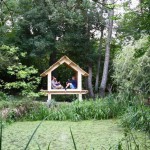Makerbay’s vehicle of the future is an autonomous electric living room
Published 13 December 2016 by Cherise Fong
At a time when electric vehicles are becoming increasingly accessible, with autonomous cars right around the corner, Hong Kong’s first makerspace has created a prototype of the vehicle of the future… which looks like a dome on wheels.
Tokyo, from our correspondent
From its digital fabrication studio in an industrial neighborhood of Hong Kong, the Makerbay makerspace is hardly trying to compete with Tesla, Bolt EV and other self-driving iCars. César Harada, Makerbay’s French-Japanese founder, explains: “The concept is a vision of what an automobile could be in the future. It’s a car that, on the outside, looks like a kind of gem. On the inside, it’s a very comfortable, friendly, modular space. The idea is that you can enter your destination on your mobile phone, dock it onto the dashboard, and the car takes you there. So it’s more of an autonomous rolling living room.”

César Harada, who leads this autonomous electric vehicle project, first came under the spotlight a few years ago with Protei, the fleet of shape-shifting, ocean-cleaning sailboats. Makerbay, as the official education partner of the Formula 1 of the future—or Formula E for electric—, set out to imagine the vehicle of the future. The project assembled a small team, including Makerbay’s technical manager Jacky Chu, who has 15 years of experience in the automobile industry.

From July 18 to August 12, 2016, leading up to Formula E, Makerbay hosted the Electric Vehicle (EV) Lab, a full workshop spread over four weeks to attract curious makers, while training them in rapid prototyping in mechanical and electrical engineering, 3D design, CNC for milling wood and metal, software coding… and, of course, intensive hands-on group collaboration.
After an initial EV hackathon, the team members dismantled a second-hand golf cart, built the skeleton and shell of the new beast, designed the dashboard, software interfaces, soft interior and solid exterior of this dream machine… all the while guided by a fundamental question: “What will you do in a silent, electric and autonomous car in 2030?”
Making of the EV prototype, by Makerbay:
If the concept of “performance and strength on the outside, pleasure and freedom on the inside” drove the design of the vehicle, its automobile components are based on the modular structure of OSVehicle (OSV), an open hardware platform that allows dedicated makers to assemble a basic car in less than an hour. Similarly, Makerbay’s autonomous electric vehicle prototype is DIY and open source, and César hopes that it will be enriched over time by other makers wishing to experiment with OSV in all its variations.
After a preview display in early October at the Gold Coast Motor Show in partnership with UBS, Makerbay’s EV prototype was exhibited during Formula E in Hong Kong on October 8-9. The experimental autonomous electric vehicle is controlled by Android, runs on three Lio batteries, has a range of 100km, a maximum speed of 40km/h… and is now called the Sapphire Voyager.
Presentation of the Sapphire Voyager, by Makerbay:
During the exhibition, Makerbay offered visitors blank sheets of paper on which was printed only a diagram of the base of the automobile to encourage them to draw their own vehicles of the future, while a virtual reality headset invited them to experience touring the streets of Hong Kong from inside the rolling living room. The local kids loved it.
While Makerbay’s EV prototype is not the first car to be entirely fabricated in a fablab (one may recall the fabcar presented at FAB10 in Barcelona in 2014), at this current stage of development, the Sapphire Voyager is made less for driving than for dreaming.
Presentation of the OSVehicle platform:
“It’s kind of Makerbay’s secret agenda to be the Techshop of the developing world, of the South, of Southeast Asia,” César explains. “It’s a makerspace that is focused on environmental and social impact, on the politics of development, working with homeless people, refugees… Our road map is built around this geography, these demographics.”
More on Makerbay’s Electric Vehicle Lab
Makerbay’s Electric Vehicle wiki

